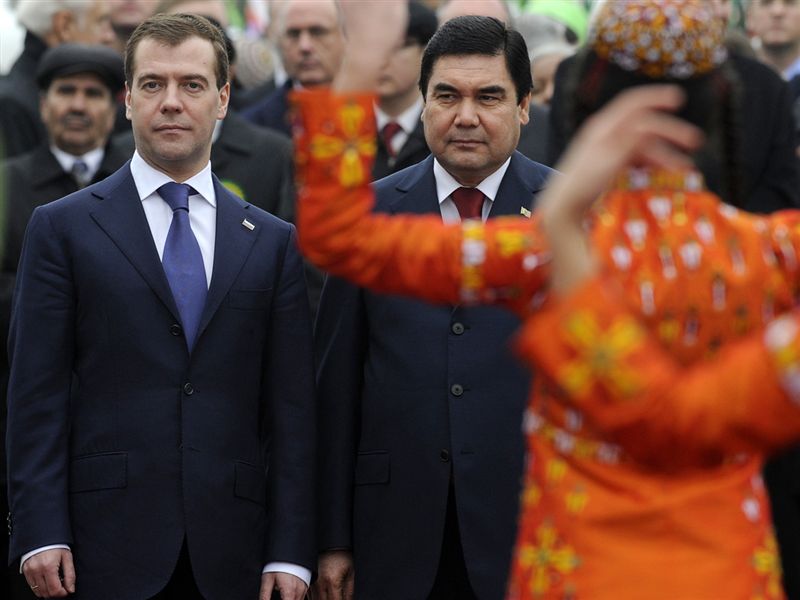
Russia Resuming Gas Imports From Turkmenistan on a Small Scale
Publication: Eurasia Daily Monitor Volume: 7 Issue: 1
By:

On December 22 in Ashgabat, Russian President Dmitry Medvedev and his counterpart in Turkmenistan Gurbanguly Berdimuhamedov witnessed the signing of documents on the bilateral gas trade and transportation. The documents mark the end of Russia’s punitive, nine-month halt of gas imports from Turkmenistan. The halt inflicted severe losses on Turkmenistan’s revenues.
However, Russia’s monopsony is now lost thanks to the opening of Turkmenistan-China and Turkmenistan-Iran pipelines in December (EDM, December 15, 16, 18). Russia is returning in a diminished role to an intensifying contest for Turkmen gas.
Gazprom’s Vice-President Aleksandr Medvedev and Turkmengaz Chairman Nury Muhammedov signed the sale-and-purchase agreement in the presence of the two heads of state (Interfax, December 22, 23). According to a subsequent announcement by Gazprom spokesman Sergey Kupryanov, deliveries would start on January 9, rather than January 1 (Interfax, December 31).
Under the agreement, Turkmenistan would deliver “up to” 30 billion cubic meters (bcm) annually to Russia from 2010 onward. However, the agreement does not specify the delivery volume for 2010, let alone subsequent years. Nor does the agreement envisage any time-frame for reaching the nominal 30 bcm target. According to Russian business press reports, Gazprom’s 2010 budget has earmarked funds for purchasing only 10.5 bcm of Turkmen gas this year (Vedomosti, December 23).
Gazprom’s purchase price for Turkmen gas is not disclosed officially. The new agreement pegs that price to the oil-products basket, potentially approximating European netback prices for Russian-delivered gas. According to unofficial reports, Gazprom’s purchase price is anticipated to range from $220 to $250 per one thousand cubic meters of Turkmen gas during 2010 (Vedomosti, Vremya Novostei, December 23).
President Medvedev claimed at the signing ceremony that this agreement is not a new one, but merely updates the 2003 Russian-Turkmen agreement on the gas trade for the period 2004-2028. Gazprom’s official announcements follow the same line and the document itself is billed as “amendments and addenda to the basic contract” of 2003. Such claims seek to maintain the illusion that Russia retains some kind of priority claim on Turkmenistan’s future gas production.
That 25-year agreement of intent –misrepresented as a “contract” by Gazprom to discourage European involvement with Turkmenistan– had envisaged Turkmen gas deliveries to Russia rising from some 40 bcm in 2004 to 90 bcm annually from 2010 onward. Russia, however, proved unable to implement that agreement, thereby implicitly invalidating it. Gazprom imported some 45 bcm of Turkmen gas per year on average, downscaled that to 42 bcm in the contract for 2009, and stopped unilaterally the import of Turkmen gas in early April 2009 due to falling demand in Russia and Europe. Consequently, Russia imported only 11.3 bcm of Turkmen gas in 2009, all of it until early April (ITAR-TASS, December 22; Vedomosti, December 23).
Furthermore, the arrangements for 2010 reduce Russia’s intake of Turkmen gas to a fraction of what it was, without stating an intention to revert to the former volumes, let alone the former projections. Those projections at 90 bcm per year far exceed pipeline capacities at Gazprom’s disposal in Central Asia. For all these reasons, Gazprom would have been in massive breach of its contract with Turkmenistan, had the 2003 framework agreement been a “contract” as claimed.
Also on December 22, Presidents Medvedev and Berdimuhamedov witnessed the signing of a document of intent on joint pipeline construction projects. One project, the Caspian coastal pipeline, would run from western Turkmenistan’s gas fields via Kazakhstan to Russia. The other project, the East-West pipeline, would connect eastern Turkmenistan’s gas fields with western Turkmenistan. There are no specifics about throughput capacities, companies involved, investment costs, or ultimate export destinations for either project (Interfax, December 22, 23).
The Caspian coastal pipeline forms the subject of an earlier agreement of intent and an inter-governmental agreement, each of them signed during 2007 by Russia with Turkmenistan and Kazakhstan. Projected at 30 to 40 bcm annually, that line was to increase dramatically the overall capacity of the Central Asia-Center pipeline system, enabling Russia to maximize its intake of Turkmen gas in the future (though well behind the schedule of the 2003 agreement of intent). Russia has been unable to move that project off the ground thus far. If built, the Caspian coastal pipeline could absorb the gas production of international companies from the Caspian offshore and send that production to Russia, instead of the planned trans-Caspian route to Azerbaijan and southern corridor to Europe.
The East-West pipeline across Turkmenistan would carry gas from the country’s supergiant fields to the Caspian shore. Depending on who would finance and build it, that line could plug either into the Caspian coastal pipeline bound for Russia, or into a trans-Caspian pipeline bound for Europe. The Kremlin had initiated the East-West pipeline project on its own terms and proposed it to Berdimuhamedov. The Turkmen president, however, announced in April 2009 an international tender for bids to construct that pipeline. Many bids are said to have been registered since then.
Russia’s continuing quest for Turkmen gas –and apparent readiness to pay realistic prices for it– reflects Moscow’s anticipation of shortfalls in Russian gas production in the post-crisis recovery period. Those shortfalls would affect Gazprom’s capacity to meet export commitments, requiring a substantial offset through imports from Turkmenistan. In the short term, Russia is content with importing relatively small volumes of Turkmen gas at 10 bcm this year, while leaving open the possibility of importing “up to” 30 bcm if and when European demand rebounds. However, China and even Iran are vying with Russia for the existing and future volumes of Turkmen gas exports, while international companies such as the German RWE proceed with development offshore.




